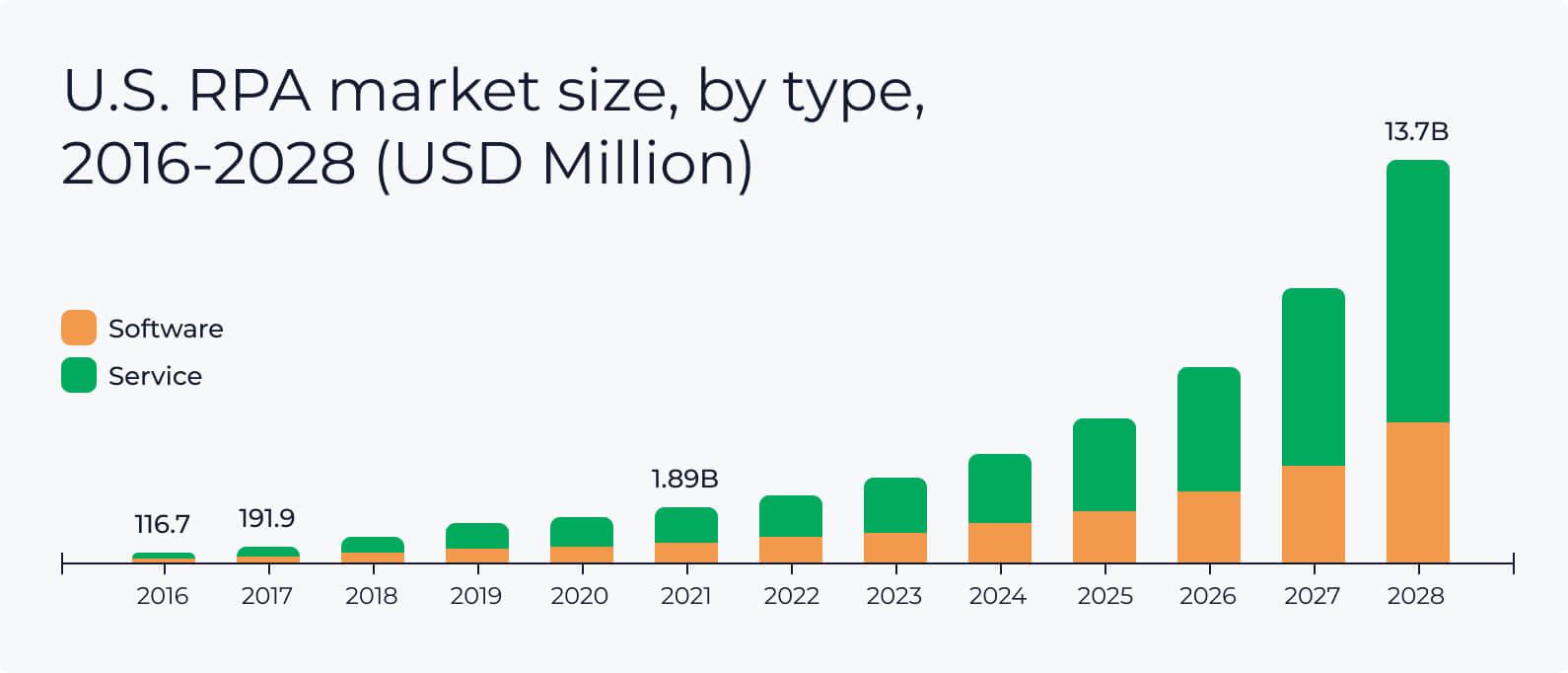
The Evolution of RPA: A 30-Year Journey
Robotic Process Automation has come a long way from UI testing and the enterprise sector and is here to stay. Discover the history behind RPA, one of the most debated trends today.
RPA: From UI testing to enterprise and RPA-as-a-service

Source: www.grandviewresearch.com
According to Grand View Research, the robotic process automation market in the US alone will exceed $12B by 2028, growing at 32.8% CAGR since 2020. Most of the growth is driven by RPA service models, where an RPA-as-a-service segment accounted for more than 61% of the market share in 2020 and is growing at the highest rate.
Modern end-to-end automation has come a long way to become the new black. This section unfolds the history of RPA and traces the technology's adoption over time. By taking this journey, you'll also learn why RPA is a strong driver of accelerating the future of entirely digitally transformed businesses.
The history of RPA
We are entering the fourth industrial revolution, the era of comprehensive automation. RPA, as a driver of this revolution, inherits cloud deployment features and mimics human cognition with unattended automation mechanics. Thousands of enterprises across the globe have already implemented the technology. To better see why it happened, let’s trace back the significant stages of the RPA development that made the technology what it is today.

Source: www.grandviewresearch.com
The 1990s: Adopting automation for UI testing
The story of RPA started with the automation of user interface (UI) testing. It usually means testing visual elements of interfaces to make sure they work correctly, and a user won’t encounter any issues working with the app.
Back in the 90s, few computer models were on the market, especially compared to nowadays. However, the primary typical computer user persona started to shift from giant corporations’ and governmental organizations’ employees to ordinary home-based users. This was mainly due to the emergence of Windows 95, the canonical operating system of that time. As a result, the shift kickstarted UI testing development as the requirements and screen sizes became more diverse.
At the end of the 90s – early 2000s, companies came to the agile development concept, one of the key values of which is prioritizing people over processes and tools. Organizations also recognized the need to speed up their operations to stay competitive. Thus, various UI testing and quality assurance (QA) automation scripts were born out of necessity.
The 2000s: Banking and insurance automation
A big part of this was screen scraping technology, which is the automation of extracting data from an application to use it for other purposes. It significantly boosted the efficiency and effectiveness of businesses that had to handle large amounts of data.
No wonder banks and insurance companies were among the first to embrace the idea.
Another reason why banks and insurance companies were the pioneers of automation is that they had resources available. However, automation technologies still had their drawbacks. One of them was a high entry threshold. If a company wanted to automate its processes at that time, it would likely result in building a complex IT environment. The latter required expensive engineering skills and time-consuming integrations.
The 2010s: Enterprise automation
The real pivotal point for the RPA technology occurred around 2012, when the technology was finally officially recognized by large-scale businesses. There was a combination of factors that made it possible, such as:
- Due to the recent financial crisis, businesses sought ways to reduce expenses.
- Businesses realized the need for digital transformation, and RPA was considered an easy and affordable (in corporate rates, of course) solution for going digital.
These factors led to RPA taking the world by storm as more and more enterprises started adopting RPA for their mission-critical tasks.
Now: Mid-market and SMB automation
The 2020s are truly the time of RPA democratization and the growing impact of RPA on all segments of economics. The democratization is possible through the gradual departure from costly licensing fees previously only affordable to enterprises to building partnerships with managed service providers to enable the RPA-as-a-service model. It allows RPA technology to expand to smaller businesses, providing SMBs with massive productivity outcomes.
We already see more and more evidence of RPA in SMBs moving from pilots and proof of concepts to real-time production in much shorter times than Enterprises do. According to the 2021 report by Xerox, one of the largest ElectroNeek partners, 80% of SMB leaders saw automating tasks and processes as crucial to their survival, with two-thirds planning on upgrading their automation tools.
Thrive Automation achieved a 10x return on investment in the first six months after adopting RPA with ElectroNeek.
Read case study →Demographics are also crucial. Since millennials and zoomers are in the workforce, they want interesting, challenging tasks, not monotonous jobs. With the help of RPA bots, companies can easily automate the work of many departments and specialists. When automation is efficiently implemented for tedious, repetitive tasks, employees become more efficient compared to previous years.
The changes in demographics and an MSPs’ focus on building recurring revenue drive the popularity of a bots-by-subscription business model. With this model, clients make periodic payments to MSPs instead of substantial upfront costs, which allows an even wider variety of companies to access the benefits of RPA.
Future of automation: Automation-as-a-service
As automation-as-a-service continues to be the major driver for RPA market growth, RPA will penetrate more companies of all sizes with the help of managed service providers. RPA workflows will leverage more technologies from an intelligent automation stack, such as optical character recognition and computer vision. These technologies, brought by MSPs to their clients through integrations with RPA platforms, will enable a much broader automation-as-a-service market that will outgrow and outperform RPA as we know it today, potentially including physical robotics with a robot-as-a-service model.
The future of work is automation, and the future of automation is service-based. Managed service providers will continue to drive the change in the market, bringing together complex technologies and skilled talent to better serve their client needs.
The bottom line
If you are a managed service provider, discover how MSPs provide RPA services and explore opportunities to start an RPA business by partnering with ElectroNeek. If you consider RPA for your company, find a trusted RPA Service provider within the ElectroNeek Network and start your RPA journey on the business terms that makes sense to your business.